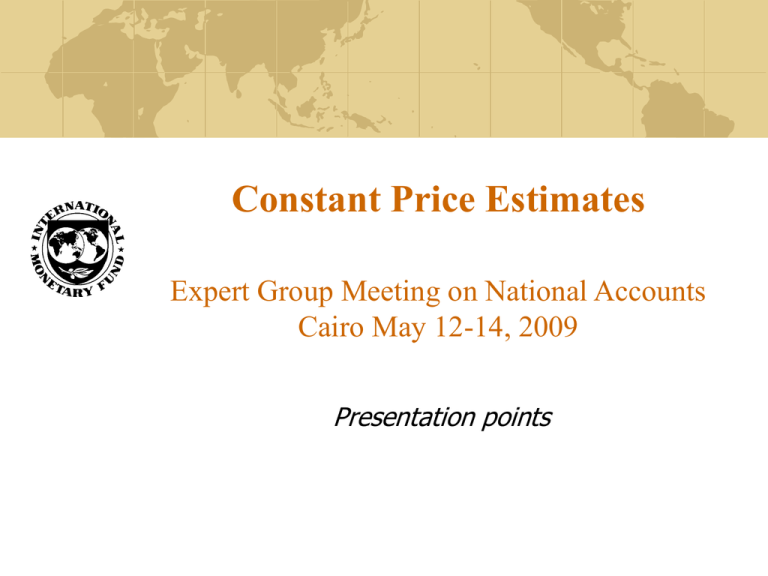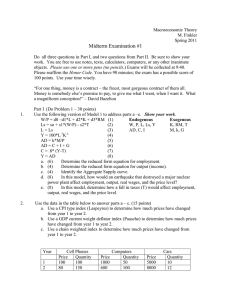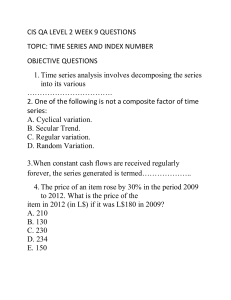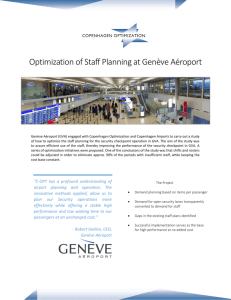Constant Price Estmates
advertisement

Constant Price Estimates Expert Group Meeting on National Accounts Cairo May 12-14, 2009 Presentation points Why national accounts statistics are compiled? Meet the needs of various users Mainly Government Private analysts Policy makers Decision takers May 13, 2009 What is the major use of national accounts statistics Assess how a country’s economy is growing over time Study the behavior of an economy at various stages in the economic cycle The changes in current price estimates over time represents combination of Change in prices Change in the underlying volumes May 13, 2009 Are national account aggregates at current price estimates enough? Do not reveal real growth of the economy The growth may largely reflect increase in prices of the produced commodities Current price estimates have two dimensions? Price Quantity What is needed? Decomposition of value in terms of prices and quantities for various commodities May 13, 2009 WHY DO WE NEED PRICE AND VOLUME MEASURES ? To properly interpret the changes in nominal figures when relative prices and/or the general price level are changing For goods and services this means that when the nominal value of goods and services transacted changes > how much is due to changes in quantity? > how much is due to changes in the prices of the goods or services? For nominal income this means that when such income increases or decreases > how much more or less of goods can be bought as a result of the change? May 13, 2009 The scope of price and volume measures in the system Price and volume measures are required > to factor the changes in the values of goods and services into components reflecting changes in their volumes and prices > measure the cash flows in real terms by deflating their values by price indices The scope of the price and volume measures also includes: Taxes and subsidies Trade margins Balancing items (value added, GDP) Compensation of employees Consumption of fixed capital Stocks of produced assets (inventories, fixed assets) May 13, 2009 Price and Volume measures in the System of National Accounts main issues What is meant by price and volume measurement for these items and their components What is the relationship between the current price value and the price and the volume measures for these items? How to aggregate them? How to obtain price and volume measures in practice? May 13, 2009 Main SNA recommendation for price and volume measures Ideal method: Annually chained Fischer price and volume indices for GDP and its components Second best Annually chained Laspeyres volume indices and Paasche price indices OR Annually chained Paasche volume indices and Laspeyres Price indices Note: When chain indices are compiled for output, intermediate consumption and value added, they are not additively consistent May 13, 2009 How are price and volume measurement for GD obtained? Through price and volume measures for its components From the production approach: for Value added by industry PLUS for taxes less subsidies on products From the expenditure approach: for government final consumption expenditure PLUS for households final consumption expenditure PLUS for NPISH’s final consumption expenditure PLUS for capital formation (and changes in invent.) PLUS for exports MINUS for imports May 13, 2009 What is meant by value (s) at constant prices It is the value(s) of a product(s) for the current period using its own price(s) from an earlier period (base year) Values at constant prices are an aggregated volume measure, expressed in money terms and additive They reflect changes in quantity and/or quality May 13, 2009 Dose the choice of base year affect growth rates? Yes The underlying weights will be different in different years Why? The rate of price change is not the same for all goods and services May 13, 2009 The usefulness of constant price series depend on? Extent of the rate of price divergence for the commodities in the measure Extent to which the relative price weights of the base period differ from the price relative weights of other periods included in the series. May 13, 2009 General Principles of Price and Volume Measurements What is meant by price and volume measurements for aggregates of goods and services How in practice to obtain price and volume measures for these aggregates How to aggregate over price and volume measures for subcomponents to obtain price and volume measures for more aggregated items May 13, 2009 Concept of Constant prices, price and volume indices The current value of a single product i at time t can be expressed as v i ,t = p i ,t * q i ,t Value of this product can be expressed in market price of previous period and construct a time series where all transactions for the product are expressed in the price of a selected base period 0 as ( p i ,0 * q i ,t ) The current value of the same product can also be expressed as v i ,t = ( p i,t /p i,0 ) * p i ,0 * q i ,t May 13, 2009 Similar set of relationships can be established at aggregated level between The aggregated rate of change of the value at current prices, and a Paasche price index and a Laspeyres volume index, The aggregate value at current prices, a Paasche price index and the aggregate value measured at constant price Vt i Vi , t i Pi , t qi , t i i Pi ,0 qi , t P0, t * Q0, t P i , 0 q i , t i Pi , t qi , t The aggregated "price" measure - a Paasche price index May 13, 2009 The aggregated "price" measure - a Paasche price index pi , 0 pi , t * qi , t pi , 0 i pi , t * qi , t wi , t P 0, t 1 i 1 i i pi ,0 * qi , t pi , t i pi , t * qi , t pi , t Paasche price index take the ratio of the value of output in current prices in year (t) to the value of output in year 0 measured in constant prices (prices of year 0) (and multiply it with 100 to convert to an index form) The ratio of any aggregate in current prices to the aggregate in constant prices yields an implicit Paasche price deflator May 13, 2009 Constant price measures Measure the monetary value of an aggregate Where Each individual quantity is valued at its own prices in an earlier period Means Period-to-period changes in constant price estimate for aggregated items Reflect changes in the quantities of the different items Aggregated Volume Measure May 13, 2009 Constant price estimates are Aggregated price measure is in monetary terms Constant price data are additive Convenient way of constructing aggregate volume measures The change from the base period constitutes a Laspeyres volume index LQ0, t qi , t pi , 0 * qi ,0 qi , t Q0, t i pi , t qi , t wi ,0 i i Q0,0 i pi , o * qi ,0 qi ,0 i pi ,0 * qi ,0 qi ,0 May 13, 2009 Relationship between value, price and Quantity indices can be established at an aggregated level Alternative index formulae for price and volume measures The Laspeyres price index LP 0, t P 0, t P 0, 0 p p i i i, t qi , 0 i, o * qi , 0 Paasche output volume index QP 0, t May 13, 2009 Q 0, t Q 0, 0 p p i i i, t qi , t i, t * qi , 0 The value of base year output at prices in the current period Pi , t qi ,0 i Pi , t qi ,0 Pi ,0 qi ,0 * LP 0, t i Pi ,0 qi ,0 * i i Pi , t qi ,0 The Fisher volume index FQ 0, t LQ 0, t * PQ0, t The Fisher price index FP 0, t Lp 0, t * PP 0, t Value index = Price index times volume index Vt FP0, t * FQ0, t ( LP 0, t * PQ0, t ) * ( LQ 0, t * PP 0, t ) V0 May 13, 2009 According to the expressions in the mentioned indices Constant price could be derived according to three methods Revaluation Deflation Volume extrapolation With the possible exception of hyperinflation situations constant price estimates derived through deflation can in general be expected to produce more accurate results than extrapolation with quantity indicators. The justification for this is that price relatives (pt/p0) generally display less variation than quantity relatives (qt/q0 ) May 13, 2009 Concept of Gross value added at constant prices Gross Value added (GVA) is a non-observable concept It cannot be decomposed into a price and a quantity component Concept of value added at constant prices can be defined and measured as: P x, i , t i Xi , j , t i Pic, i , t ICi , j , t Output at constant prices (minus) intermediate consumption at constant prices The GVA of an industry j at current and constant prices can be expressed as P i 0, i , 0 May 13, 2009 Xi , j, t i Pic, i , 0 ICi , j, t Laspeyres "volume" index GVA in j-th industry can be defined as: Ratio of GVA of j-th industry in period t at constant prices & GVA of j-th industry in the base year at the base year prices i Px , i , 0 Xi , j , t i Pic, i , 0 ICi , j , t LQIVA j ,0, t i Px, i ,0 Xi , j ,0 i Pic, i ,0 ICi , j ,0 Paasche "price" index for GVA of the j-th industry can be defined as Ratio of GVA of j-th industry in period (t) at current and constant prices i Px , i , t Xi , j , t i Pic, i , t ICi , j , t PPVA j ,0, t i Px, i ,0 Xi , j , t i Pic, i ,0 ICi , j , t May 13, 2009 Gross Value added at constant prices Measure of the contribution of an individual production unit, or a group of production units, such as an industry, to the total output at constant prices of goods and services available for final use in the economy (consumption, capital formation, and net export). A change in value added at constant prices can mean no more than a change in value added measured at some fixed set of prices and has no physical counterpart in the real world May 13, 2009 Alternative price and volume measures for GVA Paasche "volume“ index i Px , i , t Xi , j , t i Pc , i , t Ci , j , t PQVA j ,0, t i Px, i , t Xi , j ,0 i Pc, i , t Ci , j ,0 Laspeyres "price index i Px , i , t Xi , j , 0 i Pic, i , t ICi , j , 0 LPVA j ,0, t i Px, i ,0 Xi , j ,0 i Pic, i ,0 ICi , j ,0 May 13, 2009 Concept of GDP expenditure at constant prices GDP through the expenditure approach Can be expressed as an aggregate of actually observed transactions Recorded independently of the accounting framework Have a physical counterpart in the real world Can be factored into a price and a quantity component The corresponding price and quantity index in principle being a weighted average of observable price and quantity relatives. May 13, 2009 Methods of Obtaining Constant Prices GVA estimates Countries develope alternative methods to derive constant prices GVA The developed methods depends on the choice of Double or single indicator method Use of output or input related indicator Use of extrapolation or deflation type of variable on which the indicators are based All of them are variants of double indicator or single indicator methods May 13, 2009 Double deflation Since gross value added in current prices is derived indirectly as the residual item in the production account > It has no observable flows of goods and services as counterpart, and > No quantity and price components. Hence, > It may not be revalued in the prices of a base year Gross value added at constant prices is obtained as: > the difference between the output and intermediate inputs at constant prices - a process called double deflation May 13, 2009 Double deflation Double deflation means output and intermediate consumption in current prices are deflated using an appropriate (Paasche type) price index, or extrapolated from base year values by an appropriate Laspeyres-type volume index Double deflation is sensitive to error especially when > input data are not accurate, and/or > value added is a small proportion of output May 13, 2009 Single Extrapolation / Deflation As approximation of double deflation, the volume index for gross output may be used to extrapolate the volume of gross value added when > an index for intermediate inputs is not available or, > input data are not accurate The underlying assumption is that input-output coefficients are fixed so that price measures for intermediate consumption are derived implicitly Alternatively, the Paasche price deflator for output may be used to deflate the value added data in current prices The underlying assumption is that: output and input prices do not diverge significantly May 13, 2009 Single Indicator Methods (i) Single Output related indicator methods: (a) Direct deflation of current price value added by a producers’ price index (b) Direct extrapolation of base year value added using a gross output volume index. (c) Direct extrapolation of base year value added using indices based on physical quantity output measures. May 13, 2009 (ii) Single input related indicator methods: Deflation current price GVA by price index of (IC). Deflation of current price GVA by wage rate index Extrapolation of base year GVA by volume index of (IC). Extrapolation of base year GVA by index of deflated compensation of employees. Extrapolation of base year GVA by index based on physical quantities of inputs other than labor. Extrapolation of base year GVA by index of numbers employed. Extrapolation of base year GVA by an index of man hours worked. Extrapolation of base year GVA by index of hours and man-hours worked adjusted for change in labor productivity. May 13, 2009 Single Indicator Methods Cont…. Normally, The volume index for output is preferred to one based on inputs, which has greater bias because number and variety of outputs is smaller than the number of intermediate goods and services consumed in the production process commodity composition of inputs is more variable over time May 13, 2009 Specific issues Trade margins at constant prices : The trade margin is calculated as the difference between the value of the goods sold valued at current purchasers' prices and at current producers' prices The amount and value of the trade margin is not directly observable Trade margins at constant prices cannot be estimated by deflating the trade margins at current prices directly The constant price estimates of the margin can be defined as the difference between the value of the goods sold valued at constant purchasers' prices and at constant producers' prices In practice: trade margin at constant prices is obtained by many countries by simply extrapolating total trade margins in the base year with a volume index for trade turnover May 13, 2009 Specific issues ….. cont. Taxes and subsidies on products at constant prices: Do not have price and quantity components Can not be estimated by deflating current estimates directly Defined as the base year tax rate on the product multiplied by the value of the product at constant prices In practice: constant price estimates can be estimated by: > Applying the implicit base year tax rates on the relevant transactions at constant prices > Extrapolating the base year value with volume indices for the relevant transactions May 13, 2009 Constant price estimation in practice Calculation of Passche price Indexes for all parts of the national accounts is not always possible – data requirement The compromised solution is to deflate current price values at the most detailed level possible by Laspeyres deflators The outcome of this solution is an approximation of the results which would have been achieved by using Passche deflators This solutions is generally satisfactory provided that the relative quantities and/or relative prices of each item do not change significantly over time However, it is rare for such conditions to be met in practice What to do?? Revalue commodities causing problems separately from all other commodities so that the price deflators have the most up-to-date weights possible ??? May 13, 2009 The major problems Most of the price indices are compiled using the Laspeyres formula The base periods for some of the price indices differ from the base year chosen for the national accounts The weights used in compiling the available Laspeyres price indices are not updated regularly The compilation level might not be adequate to obtain an approximation for Paasche price and Laspeyres volume indices May 13, 2009 What to do?? Improve the compilation level to be at more disaggregated level? How? Do not use single deflators? Improve the price statistics? Update the weights of price indices regularly? When? Improve the level of details in the current price estimates? May 13, 2009

![Methodology Glossary [Tier 2 information ]](http://s3.studylib.net/store/data/007482938_1-dfe9be18f2dcf2b2e0ac156c7173c1b8-300x300.png)







